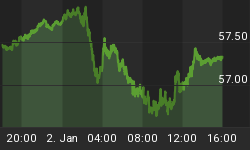The Reserve Bank of Australia is so concerned about deflation that it did a study on why prices are so low despite a 33% collapse in the Australian dollar vs. the US dollar since June 2011.
The RBA blamed competition and discounters like Aldi.
Australian Dollar vs. US Dollar

Worrying Trend
Lower prices are precisely what consumers want and need. Nonetheless, this headline from "down under" reflects prevailing silliness: Lower Prices are Just the Beginning ... of a Worrying Trend by economist Jason Murphy.
RETAIL prices have stayed low for a long time. So suspiciously low that the Reserve Bank of Australia (RBA) started to wonder if something had gone wrong.
It did a big investigation which it published last week. The reason they found? Mostly Aldi.
The RBA says we've had "a large downward shift in the average rate of retail inflation" that is not explained by labour costs or import costs. It blames technology (the internet) but also competition spurred by new foreign retailers.
Coles has cut its prices by 1.4 percent this year even though market observers have warned an all-out price war would be bad for Coles, Woolworths and IGA.
The low level of retail inflation has been a major puzzle for the boffins at the Reserve Bank. They aim to keep inflation between 2 per cent and 3 per cent a year. But retail inflation has been below that.
Retailers have not been passing on the effect of the lower Aussie dollar.
When the Australian dollar started falling, back in 2012, everyone expected retail prices would start rising. A lower Aussie dollar makes imported goods more expensive, so it makes sense we'd see higher prices on the shelves. We waited and waited. But it never really happened.
So what's happened? The RBA reports technology and foreign retailers have contributed to a climate of fear for Australian retailers. They are deeply worried about what will happen if they raise prices.
Retailers don't want to cut their margins too much, so they have been working very hard to remove the other costs of doing business.
That's the Aldi specialty -- they cut costs every way they can, like stacking things in the same pallets they arrived in and speeding up check out by not packing bags. Other supermarkets have been trying to achieve similar cost reductions with things like automated check-outs.
But all this can only go on for so long. The Aldi effect can't cause low inflation forever.
Price rises can be constrained for a while but eventually retailers are running at international best practice -- on the absolute bare bones -- and then the changes in the basic price of goods should be revealed again. Retail inflation could snap back to normal.
That will be good news at the Reserve Bank -- they get sleeplessness nights thinking about inflation. But for shoppers these happy days of prices going down down will be over -- at Coles, at Woolies, and yes, even at Aldi.
Why are Retail Prices So Low?
Let's now take a look at the RBA study Why are Retail Prices So Low?
Here's a sentence that Murpy mentioned that caught my eye as well "In a number of market segments, liaison has attributed the increase in retail competition to the actions of a perceived 'market leader', which is generally looking to expand their market share, effectively increasing supply. This has led a number of retailers to report that they believe demand for their goods is very price sensitive, and fear that they will lose sales volumes if they increase prices."
The RBA discovered "demand for goods is very price sensitive." Mercy! what a shocking revelation.
Here's a chart of the RBA's predicted model of inflation vs. what actually happened.
Retail Price Inflation

RBA Inflation Model

Don't let the math scare you. I can explain in simple terms everything you need to know.
- The model is based on "inflation exceptions" a nonsensical idea in theory, and clearly in practice.
- Constants appear in three place, any of which can be wrong.
- Measured import prices are highly likely to have errors.
- Unit labor cost measurements are also highly likely to have errors.
- When the equation blows up, it is corrected by "U", the "error term".
- If you mess with the variables enough, you can derive the "dummy model". Of course, the error factor is highly likely to be different next year than this.
RBA Conclusion
After taking everything into consideration the RBA made this statement:
Retail inflation has been surprisingly weak for a number of years. There is little evidence of a change in the direct relationship between the exchange rate and retail prices, and liaison with retailers suggests that the cost of goods sold has indeed increased due to the depreciation of the exchange rate since 2013. Rather, retail inflation appears to have been constrained by a range of other developments in the retail supply chain. Intensification in retail competition, in part driven by foreign entrants, has compressed gross margins, and firms have sought cost reductions, including through labour productivity gains, to maintain profitability.
Mish Explanation
Australia consumers are tapped out. Housing costs are absurd and people are struggling.
Aldi is not lowering prices because it wants to. Rather, consumers demand lower prices and are willing to wait for them. Stores have to lower prices if they want sales.
Economist Jason Murphy claims "But all this can only go on for so long. The Aldi effect can't cause low inflation forever."
Murphy misses the boat as much as the RBA.
Nothing is forever, especially attitudes. But it is consumer attitudes that are the driving force for low prices, not Aldi.
This attitude change can last for years if not decades. Japan is proof enough.
Once the housing bust really gets going, the RBA just might be shocked at how far off their model is.

















